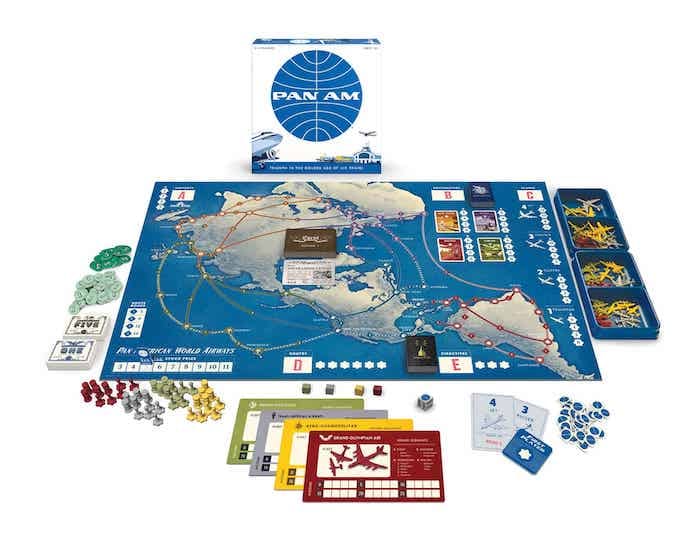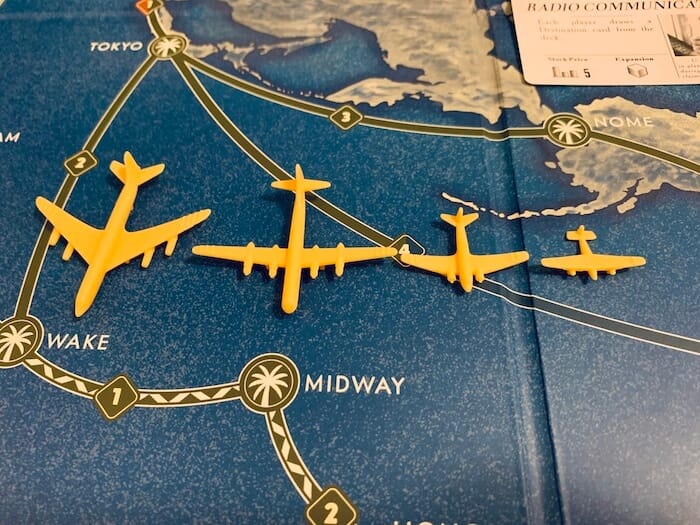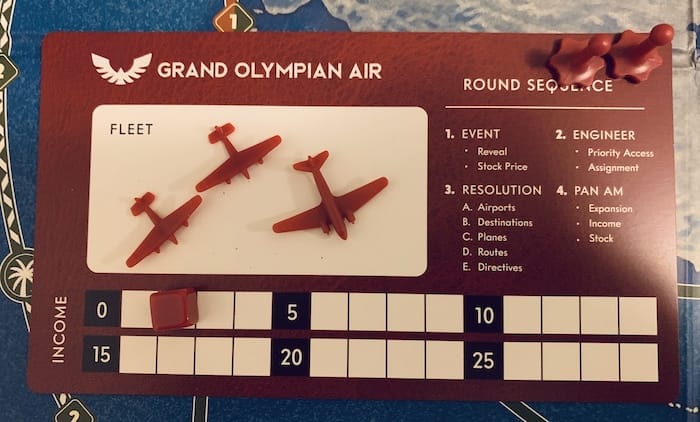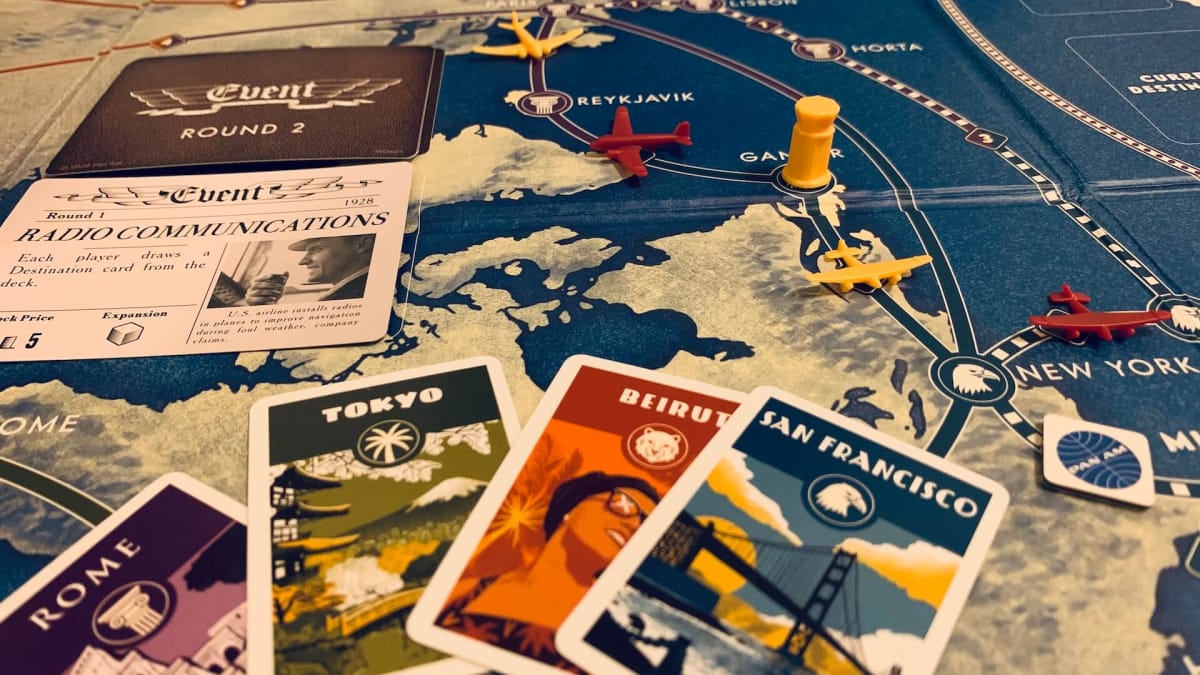The haze of cigarette smoke hangs low and heavy in the air as you wipe the sweat from your brow. You're staring down at a map of the world, and you're just not sure where to go next. As the CEO of Grand Olympian Air, you've got to somehow secure landing rights in Beijing, San Francisco, Rome, and Midway if you want to compete. But other regional airways are butting in on your territory, and then, of course, there's the behemoth. Looming over the entire airline industry is Pan American World Airways, better known as Pan Am. They keep buying up exclusive rights to routes, and they've got the money, power, and connections that you just can't compete with. Well, like the old saying goes, if you can't beat 'em, buy stock in 'em! Sounds fun, right? Welcome to Pan Am, a new route-building game by Funko Games and Prospero Hall.
For 2 to 4 players, Pan Am casts you as the head of a fledgling airline, trying to compete with your opponents (also fledgling airlines) and the ubiquitous Pan Am. Seeing as there's no way to match muscle with Pan Am, the player at the end of the game who has bought the most stock in Pan Am is declared the winner.

To do so, you'll combine worker placement with route building to earn money. You'll place your engineers on various places on the board, where you'll either be bidding for items like destination cards or airports (which help you secure landing rights in various cities around the board), bid to buy airplanes to increase your fleet or gain cards that give special actions. After you place and resolve your workers, you'll claim routes on the board. Then it's Pan Am's turn to go shopping. By rolling a custom die, Pan Am the company will randomly purchase a route moving out from Miami. If you own the route, you get paid. This can be extremely lucrative, and anticipating where Pan Am will buy next is key to staying one step ahead of your opponents. After you've placed your routes and earned some money, you'll have the option to cash in some of that money for stocks in Pan Am. At the end of seven rounds, the player with the most stock in the company wins.
Pan Am will inevitably be compared to other route-building games like Ticket to Ride, but Pan Am's got something that game (and many others like it) simply don't have: style. Style not just in the way it looks, which it does have, and I'll speak to in a minute, but style in the design sense. This is a game that takes a basic concept of building out a route and adds layers of decision making on top of it without overcrowding the design space of the game. A player new to the hobby can, thanks in large part to the very good graphic design of the game, quickly understand the options available to them, while still feeling as though they have a plethora of said options. This is a game that just feels good to play because Prospero Hall has become extremely adept at making games that just click, that doesn't tax the mental space of the gamer, and that fits their form (aka Theme) perfectly with their function (aka Mechanics).

And let's talk, for a moment, about this theme. Like the wonderfully surprising recent success of Wingspan (which is just a beautiful game about birds) Pan Am is, at first blush, perhaps not what one would imagine the gaming public screams for. Imagine pitching this game: I'm going to make a board game about an airline that went out of business in 1991. The thought is outlandish. But Pan Am, as a company, elicits a sense of nostalgia that is very specific, and it takes a visionary mind to trust that it will translate well to board gaming. But translate well it does, because of that specific nostalgia. The look of the game is exacting, as well. It's subtle, with wonderfully muted (but still rich) colors. And the illustrations on the cards make me want to travel to Paris in the 1960s (or at least watch Jacques Tati's Playtime again).

The Bottom Line:
It's interesting to see the way midcentury design, companies, and attitudes are folding back into the popular culture. This is, of course, thanks in large part to the success of pop media like Mad Men and The Marvelous Mrs. Maisel, but Pan Am was also a part of a time we can't get back, and it's a time that's easy to romanticize in our head-down, eyes on the phone, show up in sweatpants culture. I mean, people used to wear a suit just to board an airplane. All this is to say: we're beginning to rebel against our easy-access world, to turn back to vinyl, collect VHS tapes, play more tabletop games, and it makes a game like Pan Am feel, above all else, hip, and extremely of the moment, even as it looks back almost 60 years into the past. And this extra step, this extra cool factor, this is what Prospero Hall does best, they create a fantastic game that digs just a little bit deeper than everything else on the shelf.
Get This Game If...
- You're into the look and feel of its midcentury-inspired design
- You're looking for a game that's slightly more involved than the traditional route builder
- You're ready to enter a world where cocktails at lunch were totally acceptable
Avoid This Game If...
- You're looking for fantasy, sci-fi, or other genre fare
- You've always considered yourself more of a Continental person
The copy of Pan Am used in this review was provided by the publisher.
Review Summary
Have a tip, or want to point out something we missed? Leave a Comment or e-mail us at tips@techraptor.net













